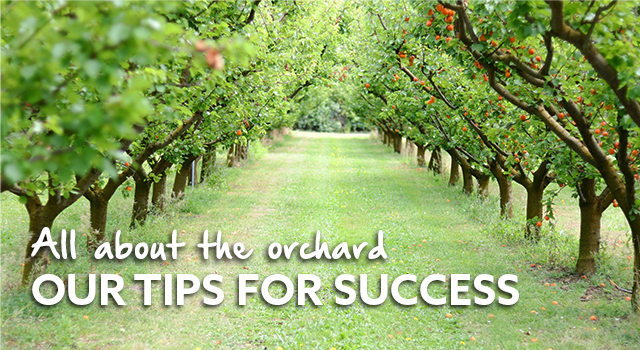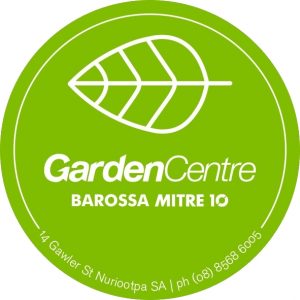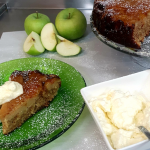All About the Orchard

ALL ABOUT THE ORCHARD
Many of us being house bound have taken the opportunity to begin a productive garden and are growing our own food. Getting out in the garden can increase your serotonin levels, and can strengthen the immune system, which of course, is just what the doctor ordered!
We’ve planted our winter veggies and now is also the perfect time to plant fruit trees. Maybe you’re thinking you have no room for fruit trees, or you may have enough room to plant an orchard! Either way there are a few considerations when choosing fruit trees.
WHAT WILL FIT?
The most significant influence in the selection of fruit trees is space and being mindful that several varieties will require a pollinator to produce fruit (ask our friendly Mitre 10 team to help you find the right pollinator). There is a fruit tree for every space – you just may need to get creative about how it fits! Maybe plant your pollinator in the same hole or pot it up! Or buy one of the many dwarf varieties available.
Did you know that up to three trees can be planted in the same hole? Simply plant them approximately 30cm apart, and pruning will prevent intertwining of branches. Simply prune the three trees as if they were one.
PICKING A GOOD TREE
So you have assessed your area and worked out what trees you need, there a few things to look out for when choosing a good tree. Look for trees that are not bruised or split, and make sure they look vigorous and have good shape. A fruit tree that can be pruned into a vase shape is ideal.
The graft union must be fully healed with no cracks, dead tissue or peeling bark. If it is not solid, it may fail in later years from the load of the fruit. With bagged trees, you can’t see the roots, but they should be undamaged with plenty of fine hair roots (the feeder roots for nutrients and water), giving you a better transplant success.
PLANTING
You’ve got the tree you want, worked out where it’s going in the garden and how you want to grow it. Now comes the time to get our hands dirty. Bare rooted trees don’t need a huge hole – only as deep as the roots are long. More important than the size, is to create an environment for the tree to thrive.
- Mix a planting compost such as Rocky Point Activ Gro to the soil at the base of the hole and firm down, form a cone in the centre of the hole over which to splay the roots.
- Pack the cone with your feet, as it keeps the tree from sinking and creating loose wet soil around the base of the trunk which promotes disease.
- Backfill with the mixture of soil and compost making sure to firm the soil around the roots. Create a broad shallow basin to capture rainwater and allow the tree to be watered deeply. Water in well with Seasol and spread a two-inch layer of compost, then mulch over the basin area but don’t pile directly against the trunk. This will provide a buffer against weather extremes.
- Finally support the with two stakes either side of the trunk so it doesn’t move in the wind, after two years the tree should have a strong enough root system to support itself.
PRUNING
Winter pruning of your tree is essential – it maintains tree health and vigour as well as encouraging fruit production. It opens up the canopy allowing more light and air circulation, keeping the tree healthier, having less problems, also restricting the size and making fruit easier to pick.
Always use equipment appropriate to the size of branch you are cutting, ranging from secateurs and loppers for the smaller branches to a pruning saw for larger. Cuts on larger limbs should be treated with Steriprune (spray or paint on) to protect from fungal diseases. Prune diseased or dead branches, and branches that cross over, and keep the centre open and a nice even shape.
PREVENTING PROBLEMS
Even without leaves, stone fruits require winter attention to prevent fungal diseases affecting your tree.
Leaf Curl is a fungal disease that affects peaches and nectarines developing on the leaves. They become thick and puckered, causing the leaves to curl and can severely reduce fruit production. To prevent this spray your tree with a low environmental impact Copper Oxychloride or Lime Sulphur spray several times before bud burst. This prevents the spores taking hold but once its started no amount of spraying can help, best to try more spray next year. Immediately remove as many affected leaves as you can, rake up the ones that have fallen and dispose of them in the bin not compost.
Gummosis is a condition where sap oozes from a wound after being contaminated by bacteria when the tree has been damaged in some way. Thorough cleaning down to healthy tissue or totally removing the limb goes a long way to treat it but sometimes heralds the beginning of the end of the trees life. Preventing damage from crossing branches, take care when mowing or snipping around the base and offering protection from wind damage that causes cracking is the best cure.
POTTED TREES
Container growing can be used for both ornamental or fruit bearing trees and when choosing a container for them, it’s always best to think big. Use a premium quality potting soil with added nutrients or you can add your own such as Blood and Bone, Dynamic Lifter, Rapid Raiser or use a liquid Go Go Juice and Nitrosol, just something mild to get it established.
Pruning for container plants above the soil is limited to damage, diseased or broken branches and branches crossing over. In terms of below the soil, prune the roots every few years, and replace the soil with new potting mix.
ESPALIER
Espalier is a great way to limit the use of space while maintaining maximum fruit production. It does take a little more effort but the process is very rewarding and attractive. The trellis should be up to 4.5m wide, with the first wire at least 40cm off the ground, and then 30cm apart after that, until you reach the height you are looking for.
Select a tree that has two limbs at least 40cm from the soil level. Plant your tree and bend the limbs to the first wire and secure with Jolly Tie (a soft stretchy plant tie), cutting the trunk just above the second wire.
When the top three buds shoot, train the lower two along the second wire and leave the top bud to grow up to the third wire making it an extension of the trunk. Other shoots should be removed and as the branches grow they need to be gently tied along the wire.
An espalier fruit tree can provide a spectacular focal point for bare areas along outdoor walls of your home and outdoor structures. Add privacy to your space by growing your own screen.
A QUICK RUN-DOWN
Almond – can be grown in a wide range of well drained soils and needs a full sun position
Apple – should be planted in moderate to well-drained soil. Fruit colour develops best with warm days and cooler nights.
Apricots – should be planted in moist free well-drained soil in a full sun position. They are mostly self fertile and do well in almost any climate.
Cherry – cool winters and warm summers are best through flowering and fruit set. Needs a regular water supply during fruiting which occurs on second year spurs.
Nectarine and Peach – are self-fertile and grow in a wide range of soils. Keep the water up to them during fruit development to ensure large fruit thinning out the crop to prevent brown rot.
Pear – require full sun, deep well drained soil with plenty of moisture. Trees may not mature for three years before fruiting but can remain productive for 75 years. Pick the fruit when mature and firm to ripen at room temperature.
Plum – not particularly fussy about soil but need as much sunlight as possible. They respond well to regular fertilising especially during fruiting.





